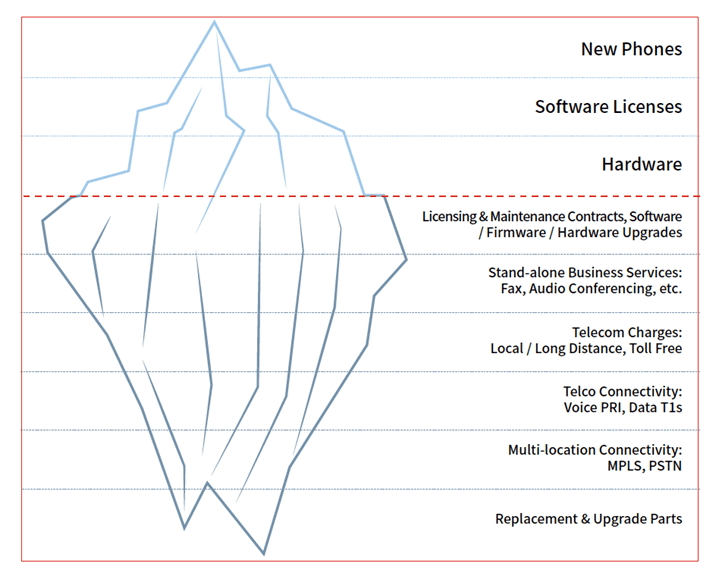There’s no going around the fact that a reliable office phone system is the backbone of every successful business. An effective communication system is crucial for establishing a link amongst the branches of your company and plays a very important role in the daily operations and growth of a business.
It is worth mentioning that most businesses understand the biggest drawbacks with an on-premises phone system revolve around manageability, flexibility, and cost. Whether you’d like to switch over to a cloud phone system or upgrade your existing system, the first thing that is likely to come to mind is the cost of getting a new system set up and running.
There are a variety of factors that will determine your final price. On-premises phone systems are highly customizable and complex, but the most obvious outlays are the ones you can see and touch – the PBX hardware and the phones that connect to it. A new on-premise phone system typically has a price tag of thousands of dollars. If you require multiple pieces of hardware to support branch satellite locations, or additional network upgrades, such as digital switches, the costs can easily mount into tens of thousands of dollars.
Due to the siloed nature of the typical premises-based system, the total cost of ownership is more than what meets the eye. In fact, once you begin to probe beneath the surface, you may realize that the hidden costs total more than the initial capital expense of the basic hardware.
Looking at the iceberg diagram above, you can see the larger story is not just about the PBX and phones.
In this article, we will be breaking down 5 of the large yet easily overlooked costs of a traditional premises-based phone system so you can make an educated decision on which type of office phone system best suits your needs.
1. PBX Phone Systems require upgrades, maintenance, and trained resources
Network upgrades, license fees, installation, and separate building wiring can quickly add up to a surprisingly large expense. In addition, as PBX systems continue to add functionality, they increasingly require highly trained support personnel to maintain the hardware and software, roll out system upgrades, and manage system use. Even if you subscribe to the manufacturer’s annual maintenance plan, your installer can require you to pay a fee to perform the software upgrade for your traditional phone system. This update can interrupt your telephone for a few hours or even days.
2. Telecom costs can be large enough to strain the IT budget
You need PRIs, bonded T1s, or other trunk lines to connect the PBX in your building to the local telco. Line items for local, long-distance, and 800 calls are also well known. However, more deeply hidden costs include the need to overprovision phone lines, and then continue paying for them. It is extremely important to adopt a proactive cost optimization strategy to ensure that you retain your competitive advantage by paying the lowest possible prices for your services.
3. Standalone services accumulate significant charge
Costs for conference calling, video conferencing, and web meetings through third-party vendors add up to substantial line items. You may also find costs for services such as eFax that managers or employees have signed up for overtime. And these charges are often applied on a per-minute basis, which can make budgeting for these bills unpredictable.
4. Connecting locations adds cost and complexity
A lot of businesses nowadays have their offices spread out in different sites across multiple locations. The need for MPLS, PSTN, or other business exchange lines to meet the demands of bandwidth-intensive communications between two sites, or among multiple sites, causes IT headaches and budget issues.
Let’s put this in perspective – if you have multiple locations, you may need additional IT resources
to manage not only the connectivity but also the additional phone system hardware. Simply enabling a remote workforce by integrating mobile applications and productivity tools is not possible with an on-premises phone system the way it is with a cloud communications solution.
5. Poor predictability of costs and feature availability—now and in the future
When you have an on-premises PBX, maintaining it 24/7, until it needs to be replaced, becomes a big job for your IT department. They also become responsible for growing your system with your company, replacing pieces as necessary. As much as your on-premises PBX is a resource, it also requires extensive resources to manage properly. The lack of system future-proofing is a looming total cost of ownership issue for any company considering a premises-based approach.
Test if a new phone system is right for your business
You’ve evaluated the pros and cons of a new phone system, but how do you know it’s the right call for your business? Will it truly reduce your monthly phone bill?
A phone audit can be a great start to find savings in your spending. Your telecommunication provider has the goal of selling you as many traditional phone lines as possible. Whereas an office equipment provider has the sole purpose of selling you the solution that will create the most value for your organization.
At Office Interiors, we audit your phone bill for potential cost savings and discover opportunities for line consolidation. On average, our customers reduce their monthly phone bills by up to 30% when switching from traditional telecom to one of our VOIP systems. We find the system that will work best for your staff by providing you with the features and technology to keep your business running smoothly.
Ahona Saha
Marketing Assistant
Office Interiors




